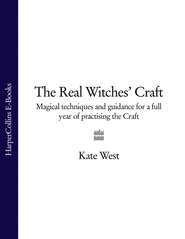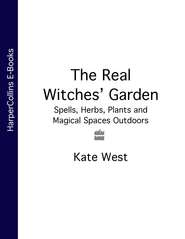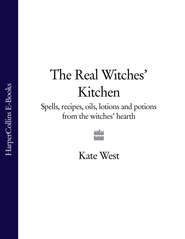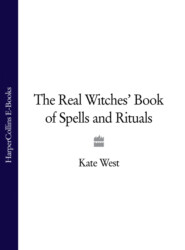По всем вопросам обращайтесь на: info@litportal.ru
(©) 2003-2024.
✖
The Real Witches’ Handbook: The Definitive Handbook of Advanced Magical Techniques
Автор
Год написания книги
2018
Настройки чтения
Размер шрифта
Высота строк
Поля
As addressed earlier, one of the misconceptions about the Craft is that Witches worship the Moon. This is not so, though the Moon is significant to Witches because the phases of the Moon represent the aspects of the Goddess and because her consort, the God, is always with her. Witches utilize those phases in their worship and their working by timing their rituals and Magic to coincide with the phases of the Moon to which they will be most attuned.
The Moon orbits the Earth, taking just over 28 days to complete its circuit. Whilst this happens the Earth orbits the Sun, taking just over 365 days to complete its circuit, and the Earth rotates on its own axis once every 24 or so hours. Bear in mind that none of these figures is precise. Time is an invention of man, not a natural or scientific law, and was created out of the need to explain these natural phenomena. As a result of all these movements, the Moon we see from Earth rises and sets at different times and in different parts of the sky and because of the relative positions of the Sun, Moon and Earth, it appears to change its shape. It waxes from a thin crescent to full circle, then wanes to a thin crescent again and finally disappears from the sky altogether for a few days before repeating the cycle. As the apparent size of the Moon changes, so does its influence on the Earth, and this is most clearly seen in its effects upon the tides. This influence can also be seen to affect humans, not surprisingly as we are mostly made of water. For women this link is easy to see in their monthly cycle, but everyone, male or female, is subject to monthly fluctuations in energy, patience, the ability to concentrate, and so on. These are often referred to as biorhythms.
Early peoples from every civilization and every part of the world have, or had, stories to explain these changes in the Moon. All of these have certain threads in common. The Moon grows, bringing promise and strength. It reaches fullness, representing fertility and fruitfulness. It declines and then enters a resting, or hidden, phase before starting again. In the Craft these stages in the Moon’s cycle are linked to the three aspects of the Goddess. In some other belief systems the Lunar cycle is linked to the stories of the God. However, legends of the Triple Goddess can be found from almost all civilizations and all parts of the globe. Although some mythologies will give different names to the different aspects of the Goddess, it is important to remember that they are all aspects or faces of the one Goddess. The Triple Goddess is Maiden, Mother and Crone (or Wise One), and we have to put aside some of our modern prejudices when we look at these terms, for Maiden need not mean young in years and Crone certainly does not mean past her useful life!
The Maiden is youthful. She represents fresh starts and new beginnings, enthusiasm and energy. In times past she would be seen as any woman who had commenced puberty but who had not yet given birth to a child. The New Moon represents the Maiden and it is at this time of the month that we prefer to work Magic directed towards new growth or anything which is being started. It is the time to draw things towards us. So we would ask for help in starting a new project or job, or to acquire new skills. On a practical level it is a good time to sow seeds or start new plants.
The Mother is more mature. She represents fertility and fruitfulness, nurturing and caring. Her image is maternal, someone who has had a child (or children) and is in the process of raising them. The Full Moon represents the Mother and this is the time of month when our Magic is directed towards healing, nurturing and protecting. At this time Magic is performed for the healing of physical, emotional and mental illness, both for ourselves and for others.
The Crone is the Wise One. She represents knowledge and understanding. In times past this was the woman who had finished raising her family, whose experience of life and observation of the people around her had given her the knowledge and skill to know those things which were not obvious to others. The later stages of the Waning Moon represent the Crone and this is the time when Magic is worked towards knowledge and understanding, and when divination is most likely to be successful. This is also the time for the banishing of things such as bad habits, old guilt, poor self-image. The Crone is also the one who presides over death, the time of rest after labours, and, because the cycle of life, death and rebirth is never-ending, she also prepares the way for new birth and the Maiden. Death is something we are accustomed to turn away from, but in the context of the Craft, its place in the cycle is necessary to allow new things to start.
The few days when there is no visible Moon every month are called the Dark of the Moon. It is often considered that these nights, when the Goddess is hiding her face, are a time when no Magic should be performed. This is not strictly true, but working at the Dark of the Moon is something which should really be kept for emergencies and for when you are fully in tune with the energies in the ebb and flow of the Moon, otherwise you may find yourself working many times harder than is actually necessary, and with uncertain results. If you practise the Craft regularly for long enough you will know when you are ready to work at the Dark of the Moon. You will also come to learn that there are very few Magics that cannot wait a day or so until the New Moon rises to lend her youthful energy to your purpose.
So far I have referred to the cycle of the Moon only in terms of the Goddess, however we must remember that the God is of equal importance. He does not change in the same way with the phases of the Moon. His role is that of consort or partner and he remains constantly at the Goddess’s side, changing little throughout the course of the month, although in a year of Moons there are some that are directly linked to the God. For example the Hunter’s Moon, which is the one nearest to Samhain and the ‘largest’ Moon of the year, is related to the God as he moves into his aspect of Leader of the Wild Hunt. The aspects of the God are seen more clearly through the cycle or Wheel of the Year, where the Goddess sometimes appears to take a less obvious role. However, both the Goddess and the God are worshipped equally in both the Lunar and the annual cycles. It may be useful to think of this in terms of two equal partners, only one of whom can speak at a time. The non-speaker may appear to take a lesser role, but in reality it is simply the fact that their partner is the one doing the talking which makes them seem to be more prominent at that time.
Witches refer to the Goddess and the God by a large number of different names and also as the Goddess and the God or the Lord and Lady. For many people this causes some confusion, for how can you believe in one deity but have a number of names? Earlier I used the analogy of a mirror ball, with each facet an aspect of the divine, known by a different name. On a more human scale, think about an individual, we’ll call her Ann. Ann is someone’s daughter, someone’s sister, wife to her husband, mother to her children. Ann also has a job; to those she supervises she is ‘boss’, to those she reports to she is a worker and to her customers she shows a different aspect yet again. Each of these roles will bring out a different facet of Ann and she may well be seen as almost a different person by all these different people, but she is still just the one Ann. At some point in Ann’s life her parents will die and at this time her role of daughter will reduce until it is almost forgotten, or she may give up work and those working roles will reduce, but should she start work again, they can quickly be revived. Individual Gods and Goddesses may likewise ‘fall into disuse’ but if their worship is revived, then their strength will grow again. For, like each of Ann’s roles, the Goddesses and Gods have personalities which can stand alone and which grow in strength if called upon more often.
The Gods and Goddesses known to Witches today come from a variety of pantheons and from a variety of times and lands. Knowledge of these deities has been spread by conquerors, invaders and immigrants throughout history and with today’s global communication that knowledge is easily shared all around the world. So you may find that Witches in America, England and Australia share the same deities, though they may follow a completely different pantheon from those in a neighbouring town.
There is no way I can give a comprehensive list of Goddesses and Gods, their stories or their roles here, but the following are just a few to give you an introduction.
PERSEPHONE, DEMETER AND HECATE
This is just one example of the Triple Goddess. The story of Persephone’s abduction by Pluto, Lord of the Underworld, is well known in its modern form but it is well worth researching the fuller tale, including the role of Hecate, who is the third aspect or Crone, and who is often called the Witches’ Goddess.
ISIS, OSIRIS, NEPTHYS AND SET
These four Egyptian Goddesses and Gods are perhaps the best known of the Egyptian pantheon. Their story is one of those which have been changed and reinterpreted so that the ‘villains’ seem all bad and the ‘heroes’ all good. However, the full story is much more complex and contains all the ingredients of a soap opera! Nepthys is often invoked as a healer, particularly in more complicated or serious cases.
VENUS AND APHRODITE
Originally these were two quite different Goddesses. The Romans were the first to confuse their Goddess Venus with the Greek Aphrodite and both have come to represent love and beauty. Venus is often invoked by Witches who wish to work Magic for forms of self-love such as increased self-respect or personal emotional healing.
CERIDWYN
In the story of this Welsh Celtic Goddess, she devours Gwion, who has stolen the potion of inspiration which she has brewed in her Magical cauldron, and gives birth to the great poet and bard Taliesin. Ceridwyn, like Hecate, is also referred to as a Witches’ Goddess.
CERNUNNOS
This Celtic God of the Hunt is one of several Gods often shown wearing antlers. Whilst his mythology is somewhat vague, a horned or antlered God is one of the older Gods of northern Europe.
THOR, ODIN, FREYA, FRIG AND LOKI
These Scandinavian Gods and Goddesses and many others share a vast mythology which is often referred to as the Northern Tradition. Whilst this tradition has much in common with Witchcraft, it is often considered to be a different path.
ENKI, INANNA, ERISKEGAL AND DUMUZI
The Sumerian Goddess Inanna is another, like Persephone, who descends to the Underworld, in this case ruled over by her sister Eriskegal. Again mourning falls upon the world until she is rescued by her father Enki. Her husband, Dumuzi, who has betrayed her, is sent to take her place. The story of Inanna is just one of many which tell us of the Descent of the Goddess, a tale which is very important in understanding the Craft and which features strongly in certain forms of initiation.
This, as I have said, is just a small selection of Goddesses and Gods, and there are many, many more. It is well worth spending some time reading up on them and their legends, for these tales give us the knowledge to select those we feel we can best work with. For example it is only when you know the role of Nepthys in the healing of Osiris that you understand why she is considered helpful in difficult cases. Also, our interpretation of Gods is often coloured by their appearance in modern productions. Anubis, for example, often appears in horror stories as a God of Death. But the ancient Egyptians believed that as the guardian of the gates of life and death, his role was as much to prevent people passing through too early as to speed them on their way when the time was right. For this reason his statue was often placed by the bed of a child as a protector.
Most Witches have their ‘favourite’ deity or deities. These will be the ones with whom they most closely identify and may even be the ones to whom they dedicate themselves and their Witchcraft. These Gods and/or Goddesses may come from one pantheon or from a mixture, but it is usual to stay within any one pantheon during the course of any one working and not mix, say, a Greek Goddess with a Celtic God, as these deities will not necessarily be in sympathy with each other and the energies they produce may cancel each other out. In any case it is not necessary to ‘mix and match’ in this way as, with a little effort, you can usually discover the name of the appropriate ‘partner’ within the same pantheon.
As almost all the information about the divine has been handed down since before the days of written history, or in some cases written in a form we cannot fully understand, such as hieroglyphs, there is often more than one way to spell any individual’s name, although one spelling may have become more accepted than others. Additionally, some quite different Gods or Goddesses may have very similar names. These are both reasons why familiarity with their roles and stories is important, so that you know exactly whom you are talking to.
Many Goddesses and Gods have a non-human form, usually in addition to their human one. This may be animal, as in the case of Arachne, Greek Goddess of weavers, who takes the form of a spider. Those of you who are afraid of spiders may find it interesting to know that meditating on the story of Arachne and making an offering to her (I usually suggest making a small spider by tying four lengths of thread together eight times at their centres and placing it in a tree) is often a large step towards overcoming arachnaphobia. Alternatively, the form of the God or Goddess might be that of a mythological creature, such as the Hydra, or may be part-human, part-‘beast’, as in the case of the Goat-Footed God Pan.
Many Witches like to have an image of the Goddess and the God on their Altar when working Magic and even just around the house generally. This can be a statue, a picture or drawing, or some other symbol. One of the easiest ways to do this is to purchase a postcard from a museum or copy an illustration from a book. If you wish to imbue your image with your own personal power it is a good idea to put at least some of the creative effort in yourself, perhaps making a statue or making the frame for a picture. Where the deity has an alternate form, like Arachne’s spider, the image may be of that form. It is not necessary to have an image of each and every Goddess or God you wish to work with, but it can be very helpful to have something around which aids your focus.
Witches do not always refer to the Goddess and the God by any name at all. Some prefer only to talk about the Goddess and the God, or even to refer to them as the Lady and the Lord. In this case the images they may keep around them may be fairly simple – a round stone with a hole through it to represent the Goddess, a phallically shaped stone to represent the God, for example. Of course, two things which represent the Goddess and the God and which are present at most rituals are the Chalice and the Athame (the Witches’ knife).
There are many reasons for wishing to have symbols of your deities around you. Perhaps the most important is so that you have a memory key. It is easier, especially at first, if you have a tangible object to focus on, rather than working purely on the mental/psychic plane. It works in much the same way as a mnemonic does, so that when you look at the image it becomes easier to remember all the attributes that you have associated with it.
However, obtaining an image of the Goddess and/or the God is only a small step in learning to worship and work with them. As I said earlier, you will need a good understanding of their personalities, roles and stories, and for this you will need first to read up on them and secondly to make personal contact. To those who have been brought up within one of the ‘orthodox’ patriarchal religions this may at first sound quite impossible – after all, that is what priests are there for in those religions. However, in the Craft we are each our own Priest or Priestess and need no intermediary to intercede with our Gods for us. We are able to make direct contact and gain personal experience of the divine.
Вы ознакомились с фрагментом книги.
Приобретайте полный текст книги у нашего партнера:
Приобретайте полный текст книги у нашего партнера:









